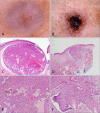Features Causing Confusion between Basal Cell Carcinoma and Squamous Cell Carcinoma in Clinical Diagnosis
- PMID: 29386834
- PMCID: PMC5762478
- DOI: 10.5021/ad.2018.30.1.64
Features Causing Confusion between Basal Cell Carcinoma and Squamous Cell Carcinoma in Clinical Diagnosis
Abstract
Background: Although squamous cell carcinoma (SCC) and basal cell carcinoma (BCC) can be easily diagnosed clinically, proper diagnosis is sometimes difficult when based on clinical information alone.
Objective: To know what causes clinical misdiagnosis between SCC and BCC, and evaluate whether dermoscopy can improve diagnostic accuracy.
Methods: Clinical and dermoscopic photographs of inversely diagnosed cases (histologically confirmed BCC with a clinical impression of SCC or vice versa) were randomly presented to six dermatologists and the reasons for each correct or incorrect diagnosis were analyzed.
Results: Among 154 cases (SCCs or BCCs), 13 cases were inversely diagnosed; 9 SCCs were clinically misdiagnosed as BCC and 4 BCCs were clinically misdiagnosed as SCC. Clinically, scales, pigmentation and rolled border were meaningful factors to discern two carcinomas. Scales without both pigmentation and rolled border was favored for SCC, but BCC favored vice versa. Ulceration, telangiectasia and translucency contributed as confusing factors for proper diagnosis. Dermoscopy improved overall diagnostic accuracy to odds ratio 2.86.
Conclusion: SCC has a higher tendency to be clinically misdiagnosed as BCC than vice versa. Pigmentation and rolled border are factors causing misdiagnosis of SCC as BCC and BCC may be misdiagnosed as SCC in the presence of scaling. Dermoscopy seems to improve the clinical diagnostic accuracy but has limitations for some ambiguous lesions.
Keywords: Basal cell carcinoma; Dermoscopy; Diagnostic errors; Squamous cell carcinoma.
Conflict of interest statement
CONFLICTS OF INTEREST: The authors have nothing to disclose.
Figures




Similar articles
-
Dermoscopic Features of Basal Cell Carcinoma on the Lower Limbs: A Chameleon!Dermatology. 2017;233(6):482-488. doi: 10.1159/000487300. Epub 2018 Mar 22. Dermatology. 2017. PMID: 29566370
-
Diagnostic accuracy of dermoscopy for 934 basal cell carcinomas: A single-center retrospective study.J Dermatol. 2023 Jan;50(1):64-71. doi: 10.1111/1346-8138.16607. Epub 2022 Oct 13. J Dermatol. 2023. PMID: 36229917
-
Line-Field Confocal Optical Coherence Tomography Increases the Diagnostic Accuracy and Confidence for Basal Cell Carcinoma in Equivocal Lesions: A Prospective Study.Cancers (Basel). 2022 Feb 21;14(4):1082. doi: 10.3390/cancers14041082. Cancers (Basel). 2022. PMID: 35205830 Free PMC article.
-
The diagnostic accuracy of dermoscopy for basal cell carcinoma: A systematic review and meta-analysis.J Am Acad Dermatol. 2019 May;80(5):1380-1388. doi: 10.1016/j.jaad.2018.12.026. Epub 2018 Dec 21. J Am Acad Dermatol. 2019. PMID: 30582991
-
Dermoscopy of Basal Cell Carcinoma Part 3: Differential Diagnosis, Treatment Monitoring and Novel Technologies.Cancers (Basel). 2025 Mar 19;17(6):1025. doi: 10.3390/cancers17061025. Cancers (Basel). 2025. PMID: 40149358 Free PMC article. Review.
Cited by
-
High-frequency ultrasound for differentiation between high-risk basal cell carcinoma and cutaneous squamous cell carcinoma.Skin Res Technol. 2022 May;28(3):410-418. doi: 10.1111/srt.13121. Epub 2021 Dec 19. Skin Res Technol. 2022. PMID: 34923684 Free PMC article.
-
Machine Learning Based Prediction of Squamous Cell Carcinoma in Ex Vivo Confocal Laser Scanning Microscopy.Cancers (Basel). 2021 Nov 3;13(21):5522. doi: 10.3390/cancers13215522. Cancers (Basel). 2021. PMID: 34771684 Free PMC article.
-
Exploring the Utilization of Imaging Modalities in the Diagnosis of Basal Cell Carcinoma: A Scoping Review.Cureus. 2024 Mar 12;16(3):e56047. doi: 10.7759/cureus.56047. eCollection 2024 Mar. Cureus. 2024. PMID: 38606243 Free PMC article.
-
Characterization of Mueller matrix elements for classifying human skin cancer utilizing random forest algorithm.J Biomed Opt. 2021 Jul;26(7):075001. doi: 10.1117/1.JBO.26.7.075001. J Biomed Opt. 2021. PMID: 34227277 Free PMC article.
-
Assessing the Diagnostic Accuracy of ChatGPT-4 in Identifying Diverse Skin Lesions Against Squamous and Basal Cell Carcinoma.JMIR Dermatol. 2025 Mar 21;8:e67299. doi: 10.2196/67299. JMIR Dermatol. 2025. PMID: 40116774 Free PMC article.
References
-
- Geller AC, Annas GD. Epidemiology of melanoma and nonmelanoma skin cancer. Semin Oncol Nurs. 2003;19:2–11. - PubMed
-
- Lee KH, Lee AY, Lee CW, Park CK, Shu JI, Kim IS. Frequency trends of basal cell carcinoma, squamous cell carcinoma and melanoma in Korea, between mid-1980s and mid-1990s. Ann Dermatol. 1999;11:70–74.
-
- Alam M, Ratner D. Cutaneous squamous-cell carcinoma. N Engl J Med. 2001;344:975–983. - PubMed
-
- Rosendahl C, Cameron A, Argenziano G, Zalaudek I, Tschandl P, Kittler H. Dermoscopy of squamous cell carcinoma and keratoacanthoma. Arch Dermatol. 2012;148:1386–1392. - PubMed
-
- Zalaudek I, Kreusch J, Giacomel J, Ferrara G, Catricalà C, Argenziano G. How to diagnose nonpigmented skin tumors: a review of vascular structures seen with dermoscopy: part II. Nonmelanocytic skin tumors. J Am Acad Dermatol. 2010;63:377–386. - PubMed
LinkOut - more resources
Full Text Sources
Other Literature Sources
Research Materials

